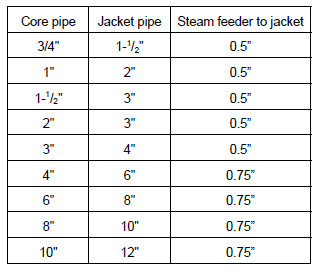A steam jacketed pipe consists of a product line which passes through the centre of a larger diameter steam line. For jacketed lines using high pressure steam, actual calculations for core jacket and feeder pipe shall be performed before finalisation of sizing.
Baffle plates, flanged joints or end caps shall be used to discontinue one feed length from the next. The size of steam feeder to jacket shall be generally 1/2″ or as specified in job specification. Flanged jumpovers shall be used in case of a flanged joint. In case of discontinuous jacketing simple jumpovers shall be employed.
The length of jacket shall be 4 to 5 meters or as mentioned in job specification. Intermediate partial baffles shall be provided if a separate branch portion is to be heated from the main line stream. Steam inlet to jacket shall generally be provided from top of the pipe in case of horizontal lines.
The jumpovers and condensate outlets shall be from the bottom. In case of vertical lines steam inlet shall be done at the topmost points and condensate outlet shall be done from the lowest possible points. Two consecutive jumpovers shall be 180 deg. apart. Each feed length shall be provided with individual trap before connecting to condensate recovery headers.
Balanced pressure / bi-metallic type thermostatic steam traps with 40 mesh strainer shall be used in jacketing. To keep proper concentricity between core and jacket pipe internal guides (rods or flat bars) shall be provided at intervals depending on the size of the pipe. Wherever anchors are provided on jacket lines proper interconnection of jacket pipe and core pipe shall have to be provided with proper jumpovers for steam. Steam jacketing inlet and outlet to be as per Jacketing standard.
 The nominal size of the inner pipe (CORE) and outer pipe (JACKET) in inches shall be as per table below unless otherwise mentioned in project piping material specification (PMS) or P&ID.
The nominal size of the inner pipe (CORE) and outer pipe (JACKET) in inches shall be as per table below unless otherwise mentioned in project piping material specification (PMS) or P&ID.
[google-square-ad]
